#otto ii of habsburg
Photo



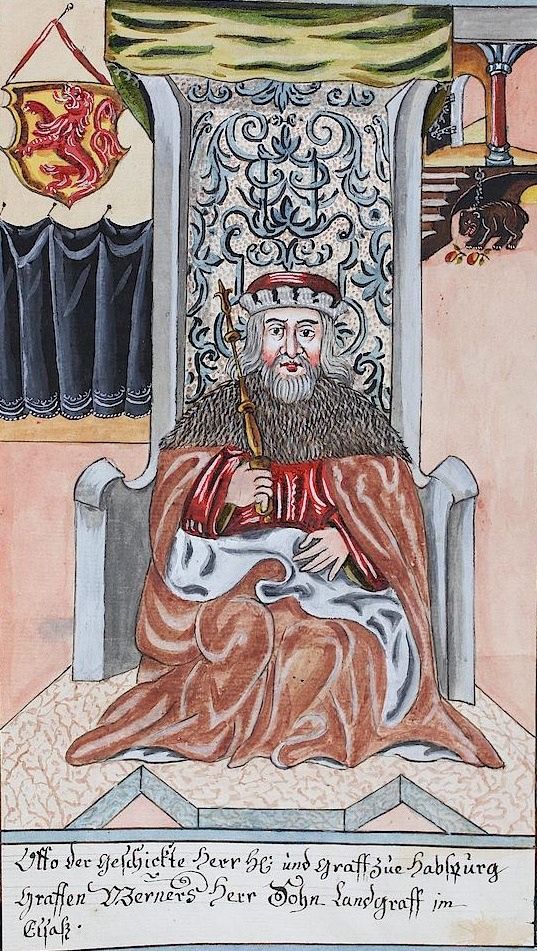


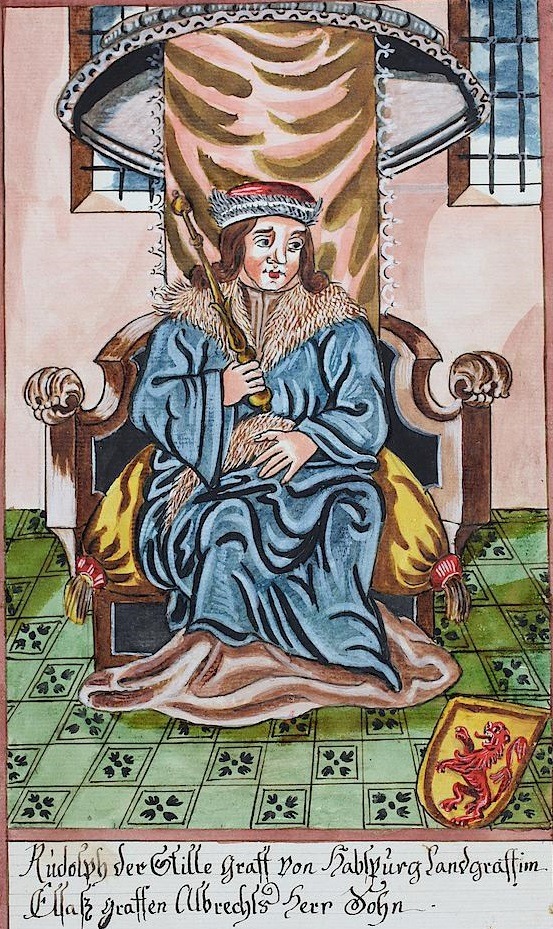
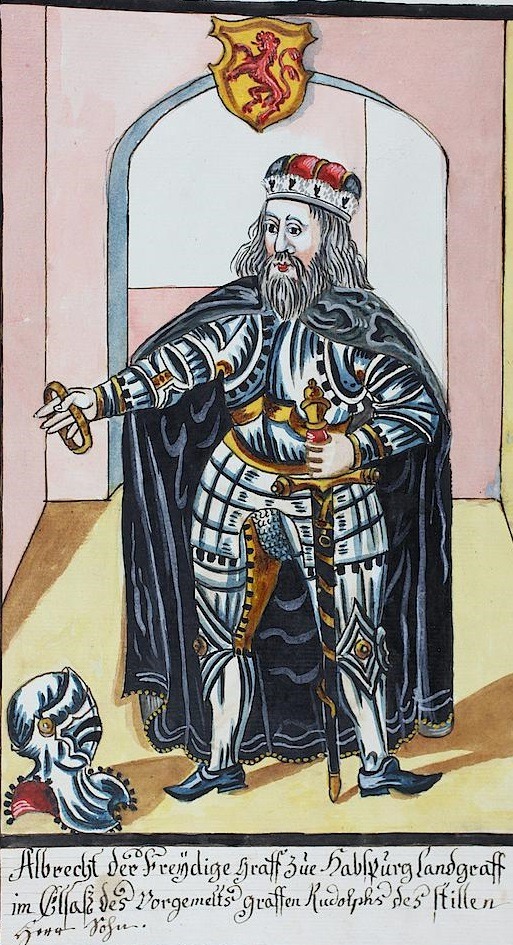
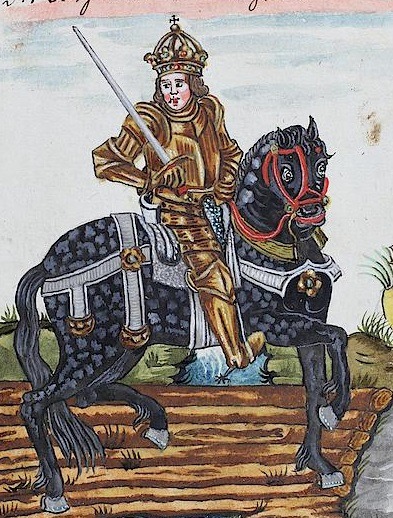
List of Monarchs: The House of Habsburg.
1. Guntram the Rich (920-973; the progenitor of the House of Habsburg and the House of Zähringen). Guntram possessed lands in Alsace and in Breisgau, from Vogesen to Kaiserstuhl and the Black Forest.
2. Radbot of Klettgau (c. 985 – 1045). He was Graf (Count) of the county of Klettgau. He built Habsburg Castle.
3. Werner I, Count of Klettgau (c. 1025/1030-1096). Sometimes called Werner the Pious. He had two sons: Otto II, and Albert II.
4. Otto II, Count of Habsburg (d. 1111). Graf (Count) of Habsburg and one of the founding members of the Habsburg family.
5. Werner II, Count of Habsburg (d.1167). He was the great-great-grandfather of King Rudolph I of Germany.
6. Albert III, Count of Habsburg (d. 1199; also known as Albert the Rich). Like his father, he was a loyal supporter of the Imperial House of Hohenstaufen.
7. Rudolf II, Count of Habsburg (Rudolph the Kind; d. 1232).
8. Albert IV, Count of Habsburg (Albert the Wise; 1188-1239). On the death of his father in 1232, he divided the family estate with his brother Rudolf III, retaining the ancestral seat of Habsburg Castle. A follower of Emperor Frederick II of Hohenstaufen, he took part in the Barons' Crusade of 1239 with King Theobald I of Navarre and died near Ashkelon.
9. Rudolf I of Germany (1218-1291).
#Chroniken der Habsburger der Zähringer und der Stadt Freiburg#german aristocracy#haus habsburg#house of habsburg#österreich#guntram the rich#rabdot of klettgau#list of monarchs#graf von habsburg#habsburg#herzogtum österreich#heiliges römisches reich#count of habsburg#House of Zähringen#Zähringer#full length portrait#werner of klettgau#otto ii of habsburg#werner ii of habsburg#albert iii of habsburg#rudolf ii of habsburg#albert iv of habsburg#in armour#full-length portrait
8 notes
·
View notes
Text




How the last Russian Dynasty were related to European Monarchies (current and former):
The House of Habsburg (Royal Dynasty of Austria) and the House of Holstein-Gottorp-Romanov (Imperial Dynasty of Russia) were distantly related, their common ancestor being Charles Louis, Hereditary Grand Duke of Baden & Francis, Duke of Saxe-Coburg-Saalfeld.
#nicholas ii#alexandra feodorovna#olga nikolaevna#tatiana nikolaevna#maria nikolaevna#anastasia nikolaevna#alexei nikolaevich#romanovs#habsburg#otto von habsburg#charles I of austria#european monarchies
60 notes
·
View notes
Text

Widowed for two years, after his first wife Margarete of Saxony gave him no children, [archduke] Karl Ludwig had married in 1862 this princess [Maria Annunziata] of the branch of the Bourbons of Naples, who gave him three sons: the archdukes Franz Ferdinand, Otto and Ferdinand Karl [and also a daughter, archduchess Margarete]. However it soon became apparent that the young woman was suffering from tuberculosis, her frequent fits of coughing, her pale complexion being signs of the disease. Her condition aggravated at the beginning of 1871. [Archduchess] Sophie is worried: “If she took an inflammation of the lungs, she would succumb to it”, she fears at the beginning of January. By May 1, the situation became alarming: Maria Annunziata “was wasting away fast. She’s an skeleton”. Informed the next day that “Annunziata is worse and asked to be administered”, Sophie goes to see her immediately. She attends on her knees to the administration of the extreme unction. After which, the dying woman wishes to be alone with her parents-in-law. She asks them to watch over her husband and children. By way of farewell, [archduke] Franz Karl makes the sign of the cross on her forehead, mouth and chest. Two days later, the poor young woman gave back her soul to God.
Bled, Jean-Paul (2018). Sophie de Habsbourg
ON THIS DAY, IN 1871, ARCHDUCHESS MARIA ANNUNZIATA OF AUSTRIA (NÉE PRINCESS OF BOURBON-TWO SICILIES) DIED. She was born in 1843 as the eldest daughter of King Ferdinando II of the Two Sicilies and his second wife Archduchess Maria Theresa of Austria. After the deposition of the Neapolitan Bourbons in 1861, she went into exile with her whole family to Rome. A year later she married her second cousin Archduke Karl Ludwig, a younger brother of Emperor Franz Josef of Austria. They had four children, among them Archduke Franz Ferdinand, whose assassination would trigger World War I, and Archduke Otto, the father of Karl I, the last Emperor of Austria.
Annunziata had suffered from a lung illness her whole life, and after the birth of her last child in 1870 her health worsened, dying a year later aged only 28-years-old. She was buried at the Capuchin Crypt in Vienna, the traditional resting place of the Habsburgs.
#i wish we knew more about her tbh#other than ''daughter of- wife of- mother of-''#but she seems to have been a nice person. apparently her sisters-in-law marie and mathilde were very fond of her#on this day in history#maria annunziata of bourbon two sicilies archduchess of austria#sophie of bavaria archduchess of austria#archduke franz karl of austria#house of bourbon two sicilies#historicwomendaily
20 notes
·
View notes
Text
ROUND 3, MATCH 2
Admin's commentary: II.Ulászló (Vladislav II.) was unexpectedly popular in this poll, but has he ran out of luck this time? Stay tuned y'all!
***

I.Károly (Karol I.) - but be honest, we all know him as Károly/Karol Róbert
1301-1342
spent the first few years on the throne fending off antikings, namely Václav III., who then gave up and passed his claim onto Otto of Bavaria, whom Károly subsequently defeated
upon his ascencion to the throne country basically ruled by the feuding nobles, also know in this period as oligarchs, he managed to consolidate his reign and regain most of the royal power trough a combination of warfare (Rozgony/Rozhanovce 1312 HELLOOO) and appeasing them with court functions
I don't even know where to START with this guy's reforms - seriously, he minted the first gold coins in Hungary, instated the banderial system (levy of the royal army from the soldiers drafted by the cities, comitates and nobles, look it was a big deal, just trust me), reformed the administation of the country and so, so much more I can't get into; basically, this man was Maria Theresa before Maria Theresa
he mostly avoided wars because of the bad shape of Hungarian treasury, though he did lead a couple of them (conflicts with Venice and Wallachia)
initiator of the 1335 meeting in Visegrád with John of Luxembourg and Casimir III. of Poland; basically, we have him to thank for the name Visegrád Four
(admin is from Košice, so he has just inherently won in her eyes because of Rozhanovce)
@tunderilona said about him: #károly róbert sweep he literally reformed the entire country
@cdqueer said about him: #hes got that anjou rizz (perfected by i. lajos <3)
@tonhalszendvics said about him: #of course károly robi had to fight off everyone in his first years#he was crowned officially in 1308#he fucked up two times before that#i mean you need to be crowned in székesfehérvár by the archbishop of esztergom with the holy crown#third time the charm he did it
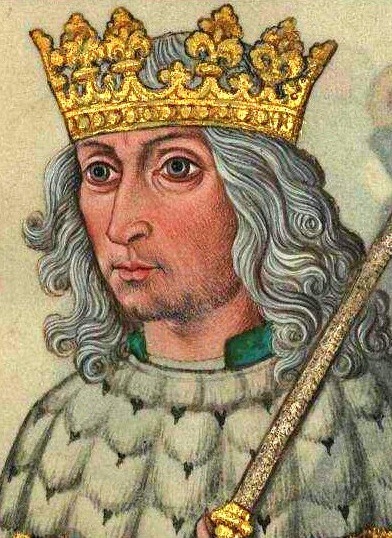
II.Ulászló (Vladislav II.)
1490-1516
I'll be honest, at this point we were at the end of the last lecture of the semester and trying to wrap shit up, our professor didn't say much about him as a person
rule of Jagiellonians in Hungary is generally remembered as a bad time, what with the continued Ottoman expansion, economic downturn and several uprisings
this dude in particular is remembered as "king Dobrze" (dobrze - "good" or "well" in Polish) for his habit of just agreeing to everything
at least he had the decency to pave the way to much more competent people by signing a treaty of succession with the Habsburgs, at the same time, he married Ferdinand I. to his daughter Anna, honestly the best decision this man has ever made
there's also some hillarious stuff with him marrying the widow of Matthias Corvinus and becoming a bigamist, but we didn't talk about that on our lectures
basically just a massive L of ruler, if this bracket was about the worst king of Hungary, he and II.András would square off in the finals
4 notes
·
View notes
Text
Deutschribing Germany
History
During most of its history, Germany was divided into several duchies, principalities, free cities, and ecclesiastical states.
Prehistory and ancient history
Germany is famous for the discovery of Homo neanderthalensis bones, as well as for having the oldest complete set of hunting weapons in the world, the oldest figurative work of art (Löwenmensch figurine), and the oldest figurative object (Venus of Hohle Fels). The latter two are attributed to the Aurignacian culture.
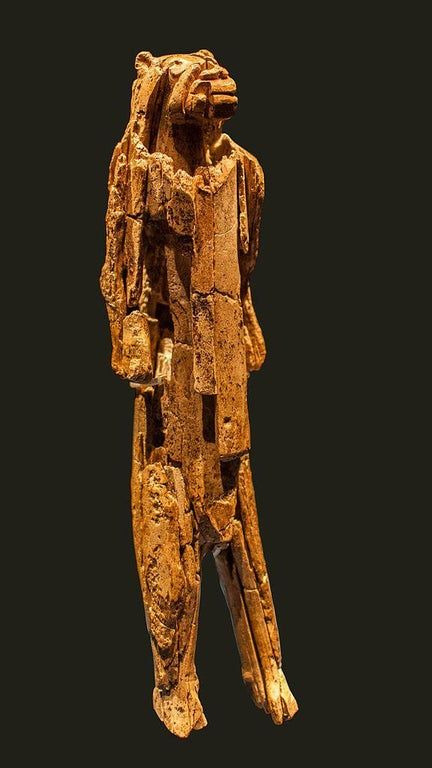
The country’s ancient history is characterized by the expansion of Germanic peoples, including the Alemanni, Franks, Goths, and Saxons. Around the same time, the Roman Empire started to invade Germanic lands, creating the province of Germania between the Rhine and Elbe rivers. Eastern Germany was inhabited by Western Slavic tribes.
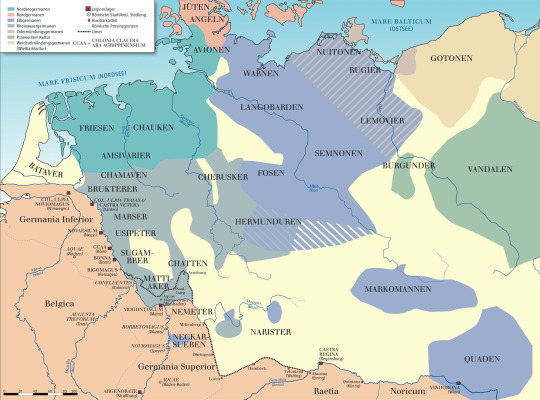
Middle Ages
The most powerful Germanic tribe, the Franks, eventually conquered many of the others, and in 800, their king Charlemagne founded the Carolingian Empire, which was later succeeded by the Holy Roman Empire, absorbing northern Italy and Burgundy.

Meanwhile, north German towns in the Hanseatic League prospered thanks to trade. This dynamic climate was the background for the invention of the printing press by Johannes Gutenberg.
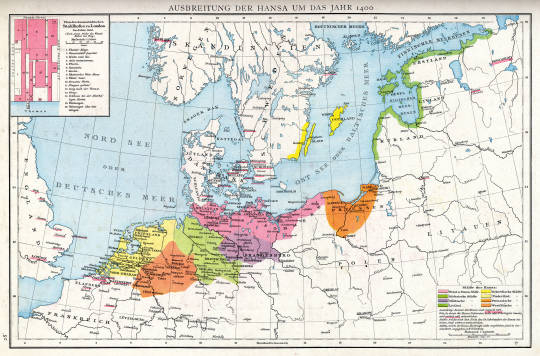
Modern history
Germany’s modern history is characterized by division, first due to religion and then as a result of the fight for political power. Following Martin Luther’s Protestant Reformation in 1517, religious conflict between Roman Catholics, Lutherans, and Calvinists devastated the country, especially during the Thirty Years’ War (1618-1648). The Peace of Westphalia ended religious warfare by allowing each state in the Holy Roman Empire to choose their official religion.

During the following two centuries, the Austrian Habsburg monarchy and the Kingdom of Prussia fought for dominance, eventually annexing free cities and ecclesiastical territories. Together with France and Russia, they competed for hegemony in present-day Germany during the Napoleonic Wars.
Following the fall of Napoleon, the 1815 Congress of Vienna founded the German Confederation, with the Austrian emperor as the permanent president. The revolutions of 1848 led to the rise of the German question, and King Frederick William IV of Prussia was offered the title of emperor but rejected it. In 1862, Otto von Bismarck was appointed as the Minister-President of Prussia and eventually defeated Austria and France. After the latter defeat, the German Empire was founded in 1871, with Prussia as the dominant constituent state and Bismarck forging alliances with Austria-Hungary and Italy.
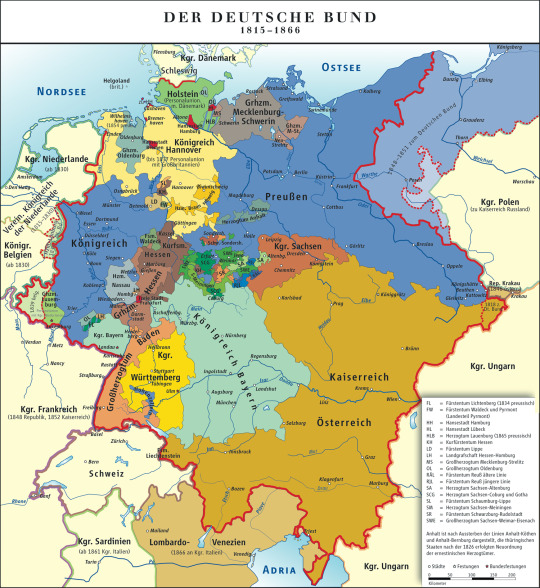
Contemporary history
When Archduke Franz Ferdinand of Austria was assassinated in 1914, Austria-Hungary declared war on Serbia, triggering World War I, which ended with Germany’s defeat and the Treaty of Versailles of 1919, because of which it lost many European territories and all of its possessions in Africa and the Pacific. The humiliation brought about by the Treaty is seen as influential in the rise of Adolf Hitler.
After the war, the Weimar Republic was established, during which there was a period of political instability and hyperinflation. The Nazi Party led by Hitler rose to power in 1932 as a result of high unemployment levels caused by the austerity and deflation policies put in place following the Great Depression. In 1933, Hitler obtained unrestricted legislative power and Germany became a totalitarian state. The regime created concentration camps for the internment of minorities, such as the Jews, Romani people, disabled people, homosexuals, and political opponents, rearmed its army, and implemented a program for economic renewal. In 1939, Germany invaded Poland, a move that started World War II. Following Hitler’s suicide, Germany surrendered, and the war ended.
The Allies, which had won the war, divided the country and its capital city into four occupation zones. In 1949, the western sectors, controlled by France, the United Kingdom, and the United States merged to form the Federal Republic of Germany (Bundesrepublik Deutschland) or West Germany. The Soviet zone became the German Democratic Republic (Deutsche Demokratische Republik) or East Germany. Konrad Adenauer was elected the first federal chancellor that same year. Both German states were reunified on October 3, 1990, following the fall of the Berlin Wall. East Germany joined the European Union as part of united Germany.
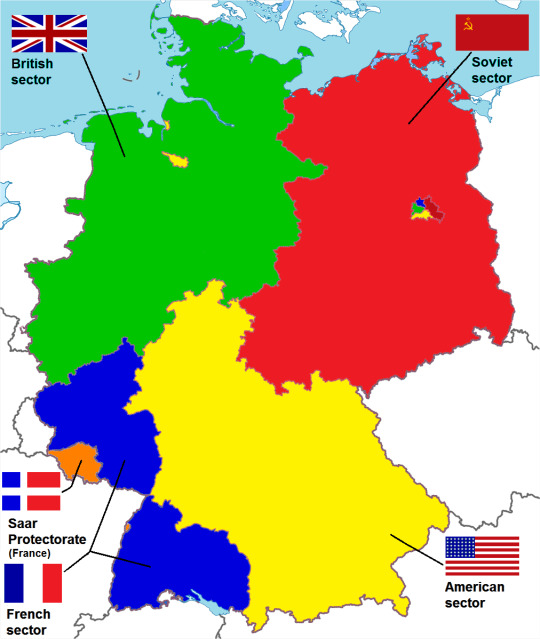
In the 2005 elections, Angela Merkel became the first female chancellor. She ruled the country until 2021.

4 notes
·
View notes
Text
Events 11.18 (before 1930)
326 – The old St. Peter's Basilica is consecrated by Pope Sylvester I.
401 – The Visigoths, led by king Alaric I, cross the Alps and invade northern Italy.
1095 – The Council of Clermont begins: called by Pope Urban II, it led to the First Crusade to the Holy Land.
1105 – Maginulfo is elected Antipope Sylvester IV in opposition to Pope Paschal II.
1210 – Pope Innocent III excommunicates Holy Roman Emperor Otto IV for invading the Kingdom of Sicily after promising to recognize papal control over it.
1302 – Pope Boniface VIII issues the Papal bull Unam sanctam, claiming spiritual supremacy for the papacy.
1421 – St Elizabeth's flood: A dike in the Grote Hollandse Waard in the Netherlands breaks, killing about 10,000 people.
1493 – Christopher Columbus first sights the island now known as Puerto Rico.
1601 – Tiryaki Hasan Pasha, an Ottoman provincial governor, routs the Habsburg forces commanded by Archduke Ferdinand II of Austria who were besieging Nagykanizsa.
1626 – The new St. Peter's Basilica in Rome is consecrated.
1730 – The future Frederick the Great of Prussia is granted a pardon by his father and is released from confinement.
1760 – The rebuilt debtors' prison, at the Castellania in Valletta, receives the first prisoners.
1803 – The Battle of Vertières, the last major battle of the Haitian Revolution, is fought, leading to the establishment of the Republic of Haiti, the first black republic in the Western Hemisphere.
1809 – In a naval action during the Napoleonic Wars, French frigates defeat British East Indiamen in the Bay of Bengal.
1812 – Napoleonic Wars: The Battle of Krasnoi ends in French defeat, but Marshal of France Michel Ney's leadership leads to him becoming known as "the bravest of the brave".
1863 – King Christian IX of Denmark signs the November constitution that declares Schleswig to be part of Denmark. This is seen by the German Confederation as a violation of the London Protocol and leads to the German–Danish war of 1864.
1867 – An earthquake strikes the Virgin Islands, triggering the largest tsunami witnessed in the Caribbean and killing dozens.
1872 – Susan B. Anthony and 14 other women are arrested for voting illegally in the United States presidential election of 1872.
1883 – American and Canadian railroads institute five standard continental time zones, ending the confusion of thousands of local times.
1901 – Britain and the United States sign the Hay–Pauncefote Treaty, which nullifies the Clayton–Bulwer Treaty and withdraws British objections to an American-controlled canal in Panama.
1903 – The Hay–Bunau-Varilla Treaty is signed by the United States and Panama, giving the United States exclusive rights over the Panama Canal Zone.
1905 – Prince Carl of Denmark becomes King Haakon VII of Norway.
1909 – Two United States warships are sent to Nicaragua after 500 revolutionaries (including two Americans) are executed by order of José Santos Zelaya.
1910 – In their campaign for women's voting rights, hundreds of suffragettes march to the British Parliament in London. Several are beaten by police, newspaper attention embarrasses the authorities, and the march is dubbed Black Friday.
1916 – World War I: First Battle of the Somme: In France, British Expeditionary Force commander Douglas Haig calls off the battle which started on July 1, 1916.
1918 – Latvia declares its independence from Russia.
1928 – Release of the animated short Steamboat Willie, the first fully synchronized sound cartoon.
1929 – Grand Banks earthquake: Off the south coast of Newfoundland in the Atlantic Ocean, a Richter magnitude 7.2 submarine earthquake, centered on the Grand Banks, breaks 12 submarine transatlantic telegraph cables and triggers a tsunami that destroys many south coast communities in the Burin Peninsula.
0 notes
Text
Current Gaming Status - The Democratic/Monarchism Anti-Bolshevik Allies
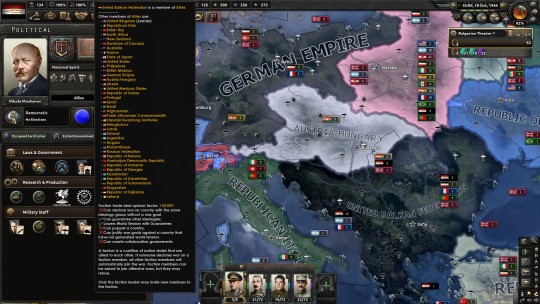
This was possibly one of the more interesting games I've played from a geopolitical standpoint, although the wars themselves were pretty easy.
I played as Bulgaria, went democratic, and unified the Balkans into the United Balkan Federation.
Germany overthrew Hitler, restored the Kaiser, and focused on building the anti-Soviet pact instead of focusing on Britain and France. Germany received Danzig in return for an independence guarantee for the Polish-Lithuianian Commonwealth, likewise maintained an independence guarantee for Finland and the Baltics. I sent an attache to help out
Hungary restored Otto von Habsburg and revived Austria-Hungary.
Japan overthrew the Toseiha, expelled Tojo to Manchura, in a civil war renewed the Anglo-Japanese alliance, and liberated Korea voluntarily. I sent an attache to help out
The United States elected Alf Landon in 1936 and pursued interventionist policies to end the policy of isolationism, focusing on European affairs.
Portugal granted limited self-rule to Mozambique and Angola.
I demanded the return of Zara. Mussolini refused and I invaded quickly, installing Ferrucio Parri as the Prime Minister and Umberto II became a constitutional monarch.
France and Britain formed the Allies. I joined after my short lived Italian war. Ireland didn't go neutral, but Belgium, Norway, and Sweden did.
The Republicans won the Spanish Civil War only with extensive Soviet aid, turning Spain into a Stalinist puppet state. Spain, annoyed by this, began to subvert Soviet control, demanding independence. The Soviet Union refused and declared war on Spain. It also declared war on Poland. Because of the Anti-Soviet Pact, Austria-Hungary, Finland, Turkey, and the United Balkan Federation went to war with the Soviet Union. Because of British guarantees to Poland, the United Kingdom went into the war and brought the Allies, including France and Japan. The USA asked Congress to declare war, and joined the Allies. With Germany and the UK against the same foe, Germany merged the Anti-Soviet Pact and the Allies into a singular commitment.
Monarchism and democracy teamed up to destroy Communism. Fascism was rendered irrelevant. Overall an easy war, but a weird one.
Full size
-SLAL
20 notes
·
View notes
Photo


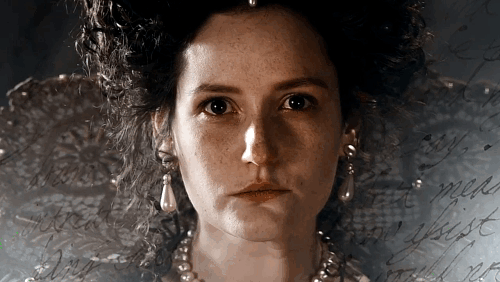
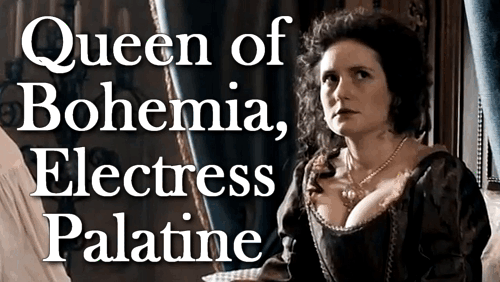

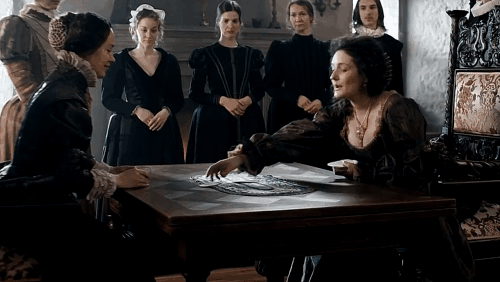
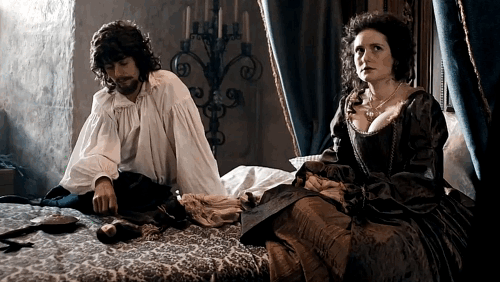
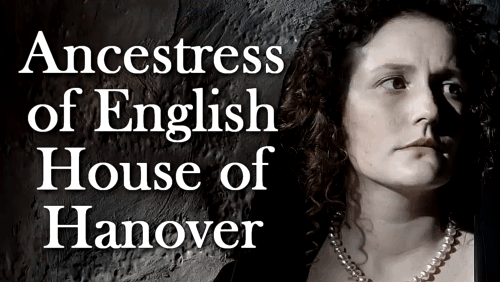
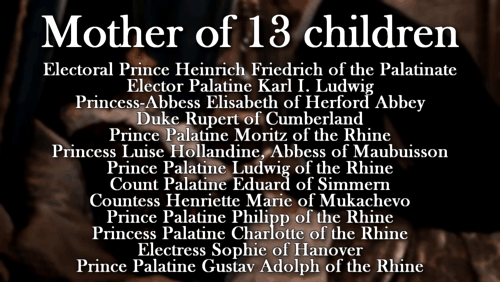
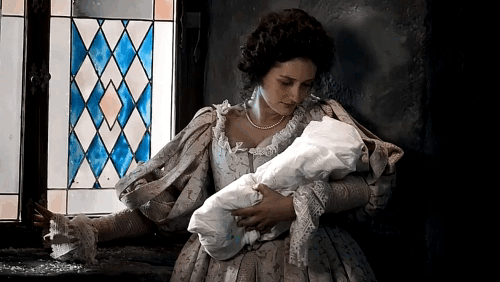
House of Stuart & of Wittelsbach: Elizabeth Stuart
Elizabeth was born as the second child and oldest daughter to King James VI of Scotland and his wife Anne of Denmark. She was named in honor of Queen Elizabeth I of England who her father would succeed as King James I of England. Only two of her siblings survived into adulthood: Prince Henry of Wales and King Charles I of England, Scotland and Ireland.
In her childhood, she moved from noble household to household. Elizabeth studied writing, riding, natural history, geography, theology, French and Italian. Her educator was warned ahead of the Gunpowder Plot. He her brought to Coventry whose citizens swore to protect her. The rebells had planed to take control of her and either place her or her brother on the throne instead of their father.
As a protestant princess, Elizabeth was a desired wedding candidate. Duke Frederick Ulrich of Braunschweig-Lüneburg, Hereditary Prince Otto of Hesse-Kassel, one of the sons of The Duke of Savoy, King Philipp II. of Spain and Elector Palatine Frederick V were interested in marrying her. She decided to marry Frederick. While her father was considering Catholic alliances, her mother was absolutely against it, which is why she did not become Philipp’s wife. The coupled wed on February 14th, 1613, at the Palace of Whitehall.
The marriage of Frederick and Elizabeth is generally described as happy one. The couple shared a love for glamour and luxury. They threw parties and banquets. But Frederick also had to deal with his own depressions which often led him to appoint Prince Christian I of Anhalt-Berleburg as regent. Elizabeth, in the mean time, enjoyed her life and made no effort to learn German. During their first five years of marriage, the couple had their first three children: Heinrich Friedrich, Karl and Elisabeth.
The Bohemian nobility dethroned Archduke Ferdinand of Inner Austria (later Holy Roman Emperor Ferdinand II) as King of Bohemia on August 17th, 1619, and elected Frederick as their king a few days later. The Habsburg have always been a Catholic house but in Bohemia Protestants had begun to rebell and started the Thirty Years’ War with the Second Defentrastion of Prague. Elizabeth did not urge her husband to take the crown but she also did not argue against it. They travelled to Prague in October and were crowned in November when Elizabeth was close to giving birth to their fourth child Rupert.
But the couple was not too popular with the Bohemian people. The Calvinist Frederick sanctioned iconoclastic furies and bathed nacked in the Vltava river alongside his wife’s ladies-in-waiting. Elizabeth’s dresses were also critized of being too risqué and her keeping dogs and monkeys was also unpopular. The Catholic League of course did not just accept the dethronement of Archduke Ferdinand. While they banded together, Frederick basically received no support from his Protestant allies. Elisabeth, again pregnant, fled to Breslau in November 1620. She moved to Küstriz to have her next child Moritz and once her husband joined them, they moved on to Berlin. Their daughter Elisabeth stayed with her grandmother Countess Louise Juliana of Orange-Nassau there, while Elizabeth and Frederick had to move on to the Netherland. Ferdinand II had put Frederick under an Imperial ban. They couple was received with great pomp by Maurice of Orange, an uncle of Frederick and then Stadtholder of the Netherlands. Since their reign over Bohemia was only one winter long, the couple is often nicknamed as Winter King and Winter Queen.
Elizabeth and her husband where financially well off in the 1620s due to the financial support she received from England and the one they received from the Netherlands. But in the years to come, Frederick even lost the Palatinate. Elizabeth however formed court of knowledge and culture in her exile. Her husband continued his fight to win back the Palatinate but died on November 29th, 1632. Elizabeth was devastated but declined an offer by her brother King Charles to return to England with her children. He reasoning to stay was that she would not give up her children’s claims to the Palatinate but if she left it would be seen as that.
Her sons continued the fight for the Palatinate but did only receive diplomatic help from their uncle. After the English civil war, even that ended. Elizabeth also no longer received her stipend of 12,000 pounds. Her relationship with most of her children worsened over time. Her youngest daughter Sophie even said once that she preferred dogs and monkeys over her own children. Her son Karl Ludwig was able to get back parts of the Palatinate in the Peace of Westphalia. But due to conflicts, Elizabeth decided to stay in the Netherlands.
Elizabeth returned to England after her nephew Charles II succeeded to newly restored English throne. She died of bronchitis on February 13th, 1662. Elizabeth is the ancestress of the British House of Hanover through her youngest daughter Sophie who was in 1701 when the Act of Settlement was passed the only living Protestant descendants of the Kings of England and Scottland.
// Rose Bursztein in Age of Iron (2018)
#Period drama#perioddramaedit#English history#women in history#historyedit#Elizabeth Stuart#historic women#Bohemian history#Czech history#German history#European history#Scottish history#1600s#17th century#House of Wittelsbach#House of Stuart#Queen Elizabeth of Bohemia#Electress Palatine Elizabeth#Winter Queen#House of Palatine-Simmern#British history
321 notes
·
View notes
Photo

this was surprisingly hard because half of them I wanted to throw in f, but then felt guilty about it so here’s where we are. explanations under the cut to be nice (fair warning: I’m writing this while tipsy so this is a journey)
S-tier
Old Fritz: look me in the eyes. look at me. are you looking? good. where else was I was going to put him? where? in C with the other losers? foolish. I am ruining my life for this man, I’m going to go into debt so I can be moderately qualified to write books on him so Tim Blanning and Christopher Clark don’t boo my off the stage. I sit here sometimes and I’m like ‘y’know, I would start a podcast to talk about his life’ as if I’m some straight white guy who thinks any of you want to listen to me for an hour. he’s a bastard, a smug bastard, and is the epitome of self-destructive tendencies. and, honestly, I wouldn’t mind if he wasn’t so fucking misogynistic all the time. ‘oh women aren’t fit to rule’ shut up Fritz before I time travel to fuck your wife and make her have one night where life feels worthwhile. but he’s funny, I enjoy how he does foreign policy, and he’s unfortunately relatable to me. cheers, Fritz. here’s to never being satisfied from one gay disaster with anger issues to another. may we burn in hell together
A-tier
Friedrich iii: “Suzanne, he was only on the throne for 99 days!! how can he be this high up when some of these bastards refused to die?” I hear you, my friends, and I have answers. I’ll tell you two words you’ll be shocked to hear put together: liberal Hohenzollern. a rare breed, isn’t it? imagine, friends, a world where he got over his throat cancer because he listened to a doctor and we get through the 1910s, 20s, even the 30s without Wilhelm II Electric Boogaloo being in power. Prussia is still on the map, the Anglo-Prussian alliance is strong, and I live in peace. but no. this stupid man had to keep smoking. because he’s selfish and doesn’t care about my needs. you know, he actually loved his wife. rare in this family. loved her and wasn’t abusive. the bar is so low, guys. and his wife is amazing too, Victoria. the world would’ve been in competent hands if they’d been in power longer (and Bismarck would’ve been out of a job still but at least these guys are smart. their son inherited grandma Vicki’s IQ). I would sleep with both of them and would thank them for the honor (when it should always be the other way around, remember that)
B-tier
Friedrich I: if your name is Friedrich and only Friedrich, we’re buds. that’s my rule. I have to give him credit where credit’s due. he was the first. while I agree with Fritz in his proscription that he was ‘small in big ways and big in small ways’ (I may have flipped that around), he wasn’t a bad guy. he just was born into the wrong job for him. I appreciate that he rode on his father��s coattails of proving useful to the Habsburgs and did a little himself to get that sweet, sweet kingship. smart move. I also like that he saw Louis XIV and said to himself “I stan, I kin, on God we’re gonna do that’ and tried. only for have his stupid, ungrateful, unclassy son to do away with that. I, too, am a woman of luxury and self-indulgance and if I had all the riches of Brandenburg and Prussia at the time (not much), I would spend them ridiculously on outfits and music and art. now, what did he do as king? what policy legacy did he leave behind? that’s a good one :)
C-tier
Friedrich Wilhelm III: now as a king he sucks. and I stand by this because, you know, he lost to him *imagine me pretending to be short and saying ‘oui, oui’ in a bad french accent*. and as any proper Englishwoman I can’t support a monarch who goes around losing to the French unless their name is Mary I. but, he’s a pathetic little man. he really is. so indecisive, so unsure of himself. what are you doing little guy? you think because your last name is Hohenzollern, God thinks you’re a good king? well it is like 1805 and, while divine right isn’t really being used as much, it’s as good as any reason on why you’re the chosen one and my family is eating dirt in Sicily and on the Scottish border. he’s really just a dude, nothing extraordinary about him except that his wife was the only one with brains and was the first to establish that (sorry Wilhelm I). he cried when he found out that his children didn’t call him ‘papa’ and went into a deep depressive state when his wife suddenly died. he’s an average man, of average abilities, but of big heart. and the big heart is what bumps him up, for me, from his old place as an F to a C. though, his moralizing is tedious
Friedrich Wilhelm II: this man should have partied with Mick Jagger and Keith Richards. everyone’s got that one ruler whose all about sex, drugs, and rock ‘n roll. for the US it’s JFK, for the UK it’s Margaret Thatcher Charles II, France has Louis XIV. Prussia has this guy and we should thank him. so many mistresses, so much sex, so much revelry and debauchery and sin! this guy’s personal life is like a treasure trove of political and sexual intrigue. if you’re into that - as I am as a town gossip - you’ll love him. I am constantly amazed by the fact that some STD didn’t kill him. syphilis, herpes, crabs. something, man, anything. but he didn’t. he’s a shit king though. absolutely horrible. all he did was whine that he didn’t get taught anything by Uncle Fritz and, yes, that’s not good if it’s true (but it’s not completely because the treatises are detailed but I guess he didn’t have time to read) but c’mon. actually apply yourself and learn on the job. I know that would’ve required him to not be balls deep somewhere, but unfortunately he’s not Dorian Gray. there’s work that needed to be done and he didn’t do it. boo!!
D-tier
Wilhelm I: apparently he was a good guy, unlike the other 3 who populate the lowest rungs of Prussian kinghood. so I give him that and I can respect that. but what did he do? what were his own ideas? I thought about putting Bismarck as king instead because, really, he was. Bismarck was a minister who ran around the king’s back to set things up exactly as he liked and it fucking worked because he was the brains. his wife was intelligent too, but theirs wasn’t a wamr and loving marriage. and Bismarck worked to get Wilhelm to distrust her because she was liberal and the fact that Wilhelm would listen to Otto even if it meant allowing himself to be drowned in the Rhine is pathetic. fun party at Versailles though. hope it was worth the war reparations
F-tier (bastard time) I’m going in a different order because I want to go from the ones I hate least to most xoxo
Friedrich Wilhelm IV: “I won’t accept a crown from the gutter” then you won’t accept a crown at all, stupid idiot! god, the smugness. the authoritarian impulses. I know it was the cool thing in 1848 to put down any revolts/protests with as much force as possible, but man, at least the Habsburgs were transparent. homie was like “yeah guys lol I’ll make a constitution and it’ll be epic! you’ll have so many rights! xoxo gossip girl” and then...nope. and AND he wanted the Habsburgs in charge of things too! Mr. ‘I’m Nostalgic For When HRE Was Great And We Blew Austrian Dick!’ grow up man. it’s Prussia time buddy, Austria is beginning to fall apart. don’t look to the past, look to the future, but you didn’t have that vision did you?
Wilhelm II: *banging pots and pans* I blame this man for everything! now, intellectually, does Germany take all the blame for WWI? no, that’s foolish and propaganda of the Allies only. if you’re a European power in 1914, you get to share the blame (ex: why did UK need to make this a naval arms race? Austria should’ve declared war on Serbia sooner if that’s what it wished to do. Russia, please stay out of the Balkans then and forever). but does my irrational hatred of Wilhelm blind me to this truth when I see his stupid face and that ugly fucking mustache that I wish to yank off? my god, yes. I see him and Rule Britannia and The Yanks Are Coming start playing so loud in my head and I’m like ‘yeah, the kaiser’s gonna pay.’ I’m sorry that Bismarck’s ego was bigger than yours but did you have to prove him right by getting incompetent buffoons who were playing checkers when he set the board up for chess to replace him? Did you have to prove Freud right by displacing private problems onto public life with your little tit-for-tat with George IV (VI?) because his mummy loved you more? Why did you need to fuck every naval vessel you saw like an inferior of Peter the Great who believed he was Sir Francis Drake? but that’s just the first war and he lived to see things setting up for the second. wasn’t in convenient for you to be close with the N@zis when you thought they might want a king back on the throne and you could reclaim your little tyrant. like every goddamn Prussian conservative or Junker, you thought you could play the tyrannical cockroach. sure, you figured out earlier that he was no pal, but you still collaborated and you still allowed yourself to get played like the weak man of conscience you are. cheers!
Friedrich Wilhelm I: ladies and gentleman, the moment you’ve all been waiting for! the biggest bastard straight outta Berlin, FW1! and who doesn’t love an abusive father? who doesn’t love a man, so insecure and pathetic, that he needs to terrorize children to be able to look at himself and have a little pride. I understand that it was because he wanted his kids, specifically Fritz, to be best. but being best and perfect meant being miniature versions of him and aren’t we supposed to want our children to be better than a carbon-copy of a small man? honestly, I could live with the occasional smack for this time period. it’s within the norm and, while horrible, isn’t irreparably damaging. this guy really had to beat the shit out of Fritz and Wilhelmina and I’m sure Augustus and Henry and Amalia and all the others (so many kids) didn’t get spared either because if you hit one, you’ll hit ‘em all. and I judge them for their flaws all the same but, for some of them, it gets hard to. because what fighting chance did they have when their father was telling them how worthless they were and beating them senseless and threatening death and life imprisonment on some? I’m constantly impressed by Henry and Fritz and Wilhelmina for amounting to any semblance of maturity, even though it’s always fleeting, because this man didn’t give them the tools to be functioning adults. but each of them managed to be greater than their father, as did Amalia managing a really cool coup in Sweden. and what did FW1 get? he built up his army, had a tall guy fetish, increased the treasury, and made the cabinet and executive offices more efficient. there used to be this one guy on here that would argue that that was all a good king made and that this lowlife didn’t deserve the contempt he got by some on here (an obvious vague of me) for his behavior as a father. and maybe I’m a crackpot, but I believe the quality of a man outshines all those other achievements and that that’s meaningless to me, in my personal life. and when I get to hell, before I go to any of these other men, I’ll go to him and ask him how hell’s fires feel because, if his God was real, it would never love him. and that’s beautiful
#i just wanted to give you guys the mental image of ol maggie doing lines of coke#i dont like her i just like to give nicknames to all my enemies#makes them uncomfortable#im very tipsy so this is weird#i apologize#but i hope its kinda funny and enjoyable#frederick the great#old fritz#the name frederick officially looks meaningless to me#frederick william i#frederick i#frederick iii#frederick william ii#frederick william iii#frederick william iv#wilhelm i#wilhelm ii#prussian shitposting
36 notes
·
View notes
Photo


It’s time for another edition of everyone’s favourite game, “Living People Related to Maria Theresa”!
Today, we have Eleonore von Habsburg-Lothringen. She is the eldest child and eldest daughter of Karl von Habsburg (The current head of the House of Habsburg Lorraine) and his estranged wife Francesca. She is a fashion model, who has worked for Dolce & Gabanna.
This is one of the ways she is related to Maria Theresa, there are multiple lines of descent through her father.
Eleonore Jelena Maria del Pilar Iona (Born February 28th, 1994) –>Archduke Karl of Austria -> Archduke Otto of Austria -> Zita of Bourbon Parma -> Robert I of Parma -> Louise d’Artois -> Maria Carolina of Naples and Sicily -> Maria Clementina of Austria -> Leopold II -> Maria Theresa
#eleonore von habsburg#eleonore of austria#maria theresa#house of habsburg lorraine#habsburg lorraine#long live the queue
33 notes
·
View notes
Photo
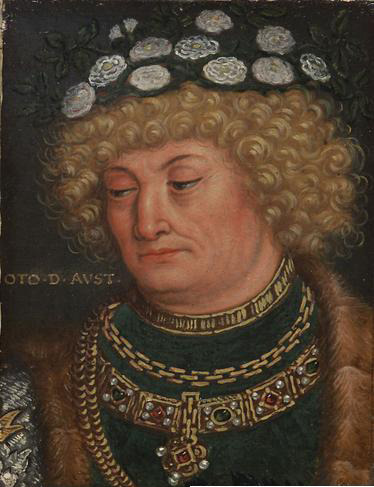




Otto of Austria (1301-1339), his successive wives and children:
Elizabeth of Bavaria (1306-1330), Anna of Luxembourg (1323-1338), Frederick II (1327–1344) and Leopold II, Duke of Austria (1328-1344).
#antoni boys#herzogtum österreich#haus habsburg#german aristocracy#herzog von österreich#Herzogtum Kärnten#duke of austria#duke of carinthia#duchy of austria#duchy of carinthia#otto of austria#otto der fröhliche#otto the merry#elizabeth of bavaria#duchess of austria#anna of luxembourg#house of luxembourg#frederick ii#leopold ii#list of monarchs#rulers of austria#house of habsburg
13 notes
·
View notes
Text

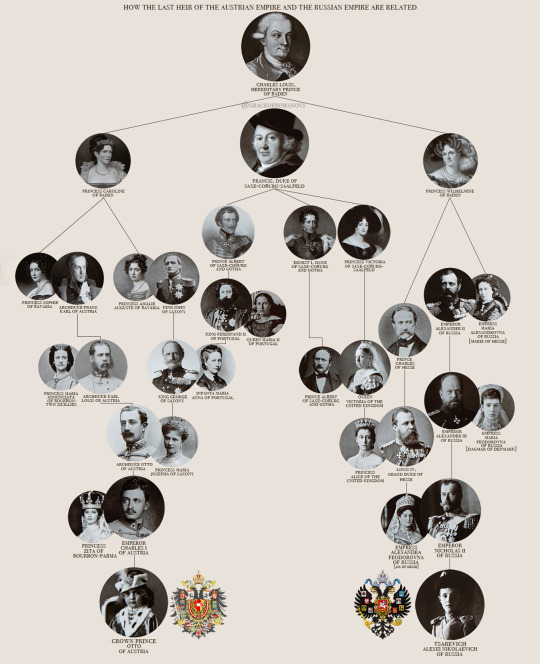
𝐇𝐨𝐰 𝐭𝐡𝐞 𝐥𝐚𝐬𝐭 𝐡𝐞𝐢𝐫𝐬 𝐨𝐟 𝐭𝐡𝐞 𝐀𝐮𝐬𝐭𝐫𝐢𝐚𝐧 𝐄𝐦𝐩𝐢𝐫𝐞 𝐚𝐧𝐝 𝐭𝐡𝐞 𝐑𝐮𝐬𝐬𝐢𝐚𝐧 𝐄𝐦𝐩𝐢𝐫𝐞 𝐫𝐞𝐥𝐚𝐭𝐞𝐝.
Tsarevich Alexei Nikolaevich, the heir to the Russian throne was born in 1904. He was the only son of Emperor Nicholas II and Empress Alexandra Feodorovna. His young life was marked with tragedy, having suffered from haemophilia, a disease which could be traced back to his great-grandmother Queen Victoria. He would be the last heir to the once great Russian Empire, when his father the Tsar abdicated for himself and for his boy in March of 1917. The Tsesarevich would be executed a year later in 1918, alongside his parents and four sisters in the basement of the Ipatiev House.
Crown Prince Otto of Austria, the heir to the Austro-Hungarian throne was born in 1912. He was the eldest son of Emperor Charles I of Austria and Zita of Bourbon-Parma. He became the heir when his father ascended the throne in 1916 until his reigned ended in late 1918, and was officially dethroned in 1919. As his father never abdicated, Otto was considered by himself, his family and Austro-Hungarian legitimists to be the rightful emperor-king from his father's death in 1922. Otto was active on the Austrian and European political stage from the 1930s, both by promoting the cause of Habsburg restoration and as an early proponent of European integration. During his life in exile, he lived in Switzerland, Madeira, Spain, Belgium, France, the United States, and from 1954 until his death, in Bavaria in 2011. At the time of his death, he was a citizen of Germany, Austria, Hungary, and Croatia.
As typical of any royals, both Tsarevich Alexei of Russia and Crown Prince Otto of Austria-Hungary were related more than once, they were 4th cousins once removed twice. Their common ancestors were Francis, Duke of Saxe-Coburg-Saalfeld and Charles Louis, Hereditary Prince of Baden.
#romanovs#history#royalty#nicholas ii#alexandra feodorovna#myedits#tsarevich alexei nikolaevich#charles i of austria#zita of bourbon-parma#otto von habsburg#habsburg#ancestry
110 notes
·
View notes
Note
Were they just honoring the exact same family members when they named Reichstadt and FJ or...Sophie gurl please.
JGJGHJSJK you know this idea actually crossed my mind, but basically yes, it just happened that the Habsburg's name pool was as big as their gene pool. But this actually is an interesting question, so let's take a super brief look at Habsburg naming!
As frustrating as it may be for us that everyone on this dynasty had the same three names, there was a logic behind it. Historian Barbara Stollberg-Rilinger in her fantastic biography of Empress Maria Theresia puts it best:
In the House of Habsburg, Christian names were always chosen from the same limited reservoir of saints, in ever varying order. The aim was not to stamp children as one-of-a-kind individuals but to mark dynastic identity and continuity.
While Stollber-Rilinger is specifically talking about the mid 18th century, some decades before the world turned upside down and many things changed forever, this naming convention kept being truth for the Habsburgs until the end of the dynasty. For example Franz Josef's son Rudolf was named after Rudolf I (1218-1291), the first king of the Romans from the House of Habsburg. The intention of marking Rudolf 's "dynastic identity and continuity" was clear. On top of that, it was also very usual to name a child after their godparent(s), who were often family members. It's not surprising, then, that most male members of the House of Habsburg in the 19th century were called a combination of Franz, Ferdinand, Karl, Josef, Ludwig, Otto or Leopold.
With that overview on Habsburg naming done, let's move on to the two cousins in question: Napoleon "Franz", Duke of Reichstadt and Franz Josef I.

From left to right: Archduke Franz Josef, future Emperor of Austria; Napoleon II, Duke of Reichstadt; Princess Maria Carolina of Bourbon-Two Sicilies, future Duchess of Aumale.
As I said before, I don't know that much about Reichstadt other than the very basics, so I apologize beforehand if there is something wrong here, since I'm not in the loop of which are the best sources about him. In the same way, if there were any particular naming conventions in the House of Bonaparte, I'm not aware of them. That being said, let's look at the King of Rome's names!
Reichstadt's full name was Napoleon François Charles Joseph. Napoleon obviously after his father, a no brainer in my opinion: Little Napoleon's birth was basically a statement that the Bonaparte empire was here to stay. Then we have "François" whose German version would become in the name he would go by during his lifetime. This was after his godfather, his maternal grandfather Emperor Franz. "Charles" was in turn after his paternal grandfather Charles Bonaparte. Finally "Joseph" came from his second godfather, his uncle Joseph Bonaparte, King of Spain.
I find this naming very interesting, because Napoleon was creating a dynastic identity, rather than continuing it. And by throwing Emperor Franz's name in the mix, he joined the identity of his new dynasty with the Habsburgs.
Now let's look at FJ's name!
Sophie and Archduke Franz Karl's firstborn was named Franz Josef Karl. Were did these names came from was surprisingly harder to check than Reichstadt's names, because all the biographies in English that I checked on the Archive just straight up skip his baptism? I had to look for information about it in András Gerő's Hungarian biography of FJ using a machine translator. As I suspected, Emperor Franz was also the godfather of this grandson. In fact, old Franz full name was "Franz Josef Karl" so my guess is that all of FJ's names are after him.
At the time of his birth Franz Josef was several people behind the throne of Austria, yet given that there wasn't much hope in Crown Prince Ferdinand producing an heir, that he might one day succeed was not out of the realm of possibility; perhaps naming him exactly like his imperial grandfather was intentional. In any case, it followed the conventional naming rules of the House of Habsburg. By the way, the future Emperor of Austria was always just called "Franz" or "Franzi" amongst his family, he chose to ascend to the throne by the name of "Franz Josef" because he also wanted to be associated with Emperor Joseph II. Yet another example of Habsburg names marking "dynastic identity and continuity".
Now to finish the ask let's address the elephant in the room, the reason why are we looking at the names of these two cousins in particular instead of literally anyone else. Could Reichstadt had been, in fact, FJ's father?
Rumors about Reichstadt and Sophie being too friendly had in fact been going on even before Franz Josef was born. However, I think pretty much no one believes that him being the future emperor's father is possible. Let's look at what one of Reichstadt's biographers, Octave Aubry, has to say about this:
It has been asserted that Reichstadt was the father of Franz-Josef. The contention does not stand investigation. The friendship between the two lovers did not begin until after the birth of Sophie’s first child. As for her second, Maximilian, who was to be born in July, 1832, and to die in Mexico, such a filiation is not at all impossible. But in that direction everything is conjecture. If the two lovers themselves knew, they kept their secret. They loved each other: that is the only thing certain.
I've only read some fragments of this biography very superficially, but just by this you can tell that Aubry not only believes that an affair indeed happened, but also that he totally ships Reichstadt and Sophie lol. So if even him, who I believe is one of the main biographers to held the belief that they were more than close friends, doesn't buy into the rumors, then truly there isn't any evidence to back this up. About what I think about Max potentially being Reichstadt's son I already answer it in another ask.
Finally, I wanted to note that Reichstadt was very fond of his little cousin Franz Josef. He would often play with with him, and took him in his walks with Sophie. I found in Aubry's biography this very touching moment between them from when Reichstadt was already on the verge of death:
He asked to have little Franz-Josef brought to his room, for the lad’s charming ways delighted him. He stroked his hair repeatedly, and showed him little objects that he thought would amuse him and then finally held him in a tight embrace for a moment, dreaming. The child looked up at him, earnest, bored perhaps. His nurse came for him and his big cousin released him with a sigh.
I like to believe that Reichstadt was happy to share names with the cousin he loved so much.
#tl;dr: they were both named after emperor franz. i just ended up going down a ridiculously deep naming rabbit hole sorry#and now I legit feel like tearing up a bit dfgdfgk#also if you can't tell already my napoleonic subjects of interest are literally just napoleon's sons lol#napoleon ii duke of reichstadt#franz josef i of austria#franz i of austria#asks
33 notes
·
View notes
Photo

Biography of Queen Isabella
Early Life
Born 1 November 1992 in Geneva Switzerland to Archduke Carl Christian of Austria & Princess Marie Astrid of Luxembourg later Archduchess Marie Astrid of Austria. Archduchess Isabella Maria Anna Charlotte Elisabeth Ingeborg of Austria was the 5th of what would later become 6 children. With an older sister, three older brothers, and a younger sister Archduchess Isabella's life was filled with many close family members. Archduchess Isabella was christened in Zwiefalten Abbey in Baden-Wuttermberg, Germany. Her godparents were Queen Fabiola of the Belgians, Alois, Hereditary Prince & now Regent of Liechtenstein, and Maria Teresa, Hereditary Grand Duchess of Luxembourg then The Grand Duchess of Luxembourg. Two are usually chosen to be godparents, but Maria Teresa, later The Grand Duchess of Luxembourg was added to be a godparent after saving Archduchess Marie Astrid's life during her pregnancy with Isabella. Upon her baptism, Queen Fabiola of the Belgians called her "petite reine" which a nickname that her grandmother Josephine Charlotte, Grand Duchess of Luxembourg picked up soon after. Isabella grew up in Geneva with 5 other siblings while her father was a banker and her mother worked for the Luxembourg Grand Ducal Family as the daughter of the Grand Duke of Luxembourg.
Isabella's childhood was spent with her 5 other siblings, parents, and over 3 dozen cousins from Liechtenstein, Austria, Luxembourg, and Belgium. Her childhood was spent in Switzerland with holidays to Luxembourg, France, Spain, and Belgium. She spoke German and French in her early years and learned English and Spanish as a young girl. Though she does speak Dutch, Luxembourgish, Russian and Italian, those are not fluent languages that Isabella uses often. Isabella was sent to a boarding school in Kent, England where she was educated for 4 years until moving to Virginia, United States to another boarding school. Isabella went to Sevenoaks School in Kent, England alongside Prince Amedeo of Belgium, Archduke of Austria-Este and Princess Luisa Maria of Belgium, Archduchess of Austria-Este.
Archduchess Isabella went to Yale University and graduated in 2014 with a Master's Degree in Global Affairs and a Bachelor's Degree in Political Science. Her summer's during college where spent in third world nations with 2 different humanitarian groups alongside her cousin Princess Alexandra of Luxembourg. After her graduation Isabella immediately returned to Geneva where she began working for her father only to leave that job a couple of weeks later and began her work with the United Nations as a Human Rights Officer.
Marriage
Mid 2016 it was revealed that Archduchess Isabella of Austria and Prince Harry of Wales were well into their own relationship that was reported to have started in November of 2014 while Isabella was working for her father. This would later have said to be false but none in the British Royal Family would confirm if the marriage was indeed arranged at the time.
Prince Harry and Archduchess Isabella announced their engagement in January of 2017 with a wedding to be in the summer of that same year. The two became engaged at Fischbach Castle in Luxembourg during the Christmas holiday in the presence of the Luxembourg Grand Ducal Family and extended family. The wedding took place at St. Paul's Cathedral with 3200 guests in attendance. A majority being over 500 descendants of Robert I, Duke of Parma, who was the twice great-great-grandfather of Archduchess Isabella.
The wedding party, was the largest ever seen in a British Royal Family wedding at the time. Excluding the maid of honor, Archduchess Isabella and Prince Harry had 12 bridal attendants, 6 boys and 6 girls, all godchildren and family friends of the bride and groom. The maid of honor was chosen as Princess Charlotte of Nassau, a first cousin of Archduchess Isabella and a great-great-granddaughter of King Alfonso XIII of Spain and Queen Victoria Eugenie. Other attendants included Princess Eleonore of Belgium, daughter of King Philippe and Queen Mathilde of Belgium; Countess Xenia von Coudenhove-Kalergi, Granddaughter of Vincenz Liechtenstein; Archduchess Maria Stella of Austria, Isabella’s niece by her brother Archduke Imre; Archduchess Zita of Austria, Great-Granddaughter of Archduke Carl Ludwig of Austria; Princess Florence of Ligne, Granddaughter of Alix, Dowager Princess of Ligne; Prince Gabriel of Nassau, son of Prince Louis of Luxembourg; Count Rodolfo Secco de Aragona, Grandson of Archduke Rudolf of Austria; Archduke Luigi of Austria-Este, Grandson of Robert, Archduke of Austria-Este; Prince Valerian of Lobowicz, Grandson of Andrea von Habsburg; and Japer Dyer, son of Mark Dyer. The wedding was estimated to be watched by over half a billion people, making it one of the most watched events in British history.
House of Habsburg-Lorraine and the main and cadet branches of the House of Bourbon made up a majority of guests as relations to Archduchess Isabella. Other German, Danish, Dutch, Luxembourgish, and Belgian nobility were also invited as family of bride.
On the morning of the wedding Prince Harry was made Duke of Sussex, Earl of Ross, and Baron Hartland. Because Isabella was born an Archduchess of Austria and her title being higher than that of a Duchess, Isabella was formally introduced as Archduchess Isabella of Austria, Duchess of Sussex, Countess Ross, and Baroness Hartland. Buckingham Palace then issued a statement that Isabella will still be addressed as Archduchess and not Duchess, but her titles by marriage will also be used when formally addressed.
Children
December of 2017 Clarence House released a statement that Archduchess Isabella and Prince Harry were expecting a child in the summer of 2018, later Prince Harry revealed that no one in the royal family knew per request to keep everything as quite as possible. Clarence House released a statement that Archduchess Isabella gave birth at Château de Belœil in the early morning of 24 of May. A statement was released of the two boys named Charles Henry Ferdinand Baudouin Jean Philip, Earl of Ross and Lord Albert Maximilian Christian Leopold Felix Ludwig. The Earl of Ross’s godparents included Mark Dyer, King Philippe of Belgium, Jake Warern, Princess Margaretha of Liechtenstein, Guillaume, Hereditary Grand Duke of Luxembourg and Prince Seesio. Lord Albert godparents were Princess Beatrice of York, Prince Henri Antoine of Ligne, Edward Lane Fox, Alexander Fellowes, Princess Sophie of Liechtenstein, and Princess Maria Gabriella of Orleans-Braganza.
With their birth, pressure was put on the British monarchy to make them Princes, rather than lord because their parents' marriage was dynastic to the older generation. Due to being the children of the Duke of Sussex, any children from their marriage were not given the title of Prince. All of Prince Harry's children born during the reign of their great-grandmother Queen Elizabeth II would have the title of Lord and Lady with the eldest son receiving the subsidiary title of Prince Harry, The Duke of Sussex. Jean, the former Grand Duke of Luxembourg advised his son, Isabella's uncle, Henri Grand Duke of Luxembourg, to recognize the Dukedom of Sussex into the Luxembourg nobility and allow them to have his great-grandchildren to have title of Prince and Princess. The Grand Duke of Luxembourg was to give all children of Archduchess Isabella, the title of Prince/Princess of Sussex in Luxembourg nobility. By government advisement, the Grand Duke did not bestow any titles.
A second pregnancy was announced in November 2018. During Archduchess Isabella's second pregnancy, Isabella and Prince Harry to moved out of Kensington Palace and to St. James’ Palace to accommodate their growing family. May 26, 2019 Archduchess Isabella gave birth to Mary-Astrid Jeanne Zita Ingeborg Josephine Christine Diane at Berg Castle in Luxembourg. Mary Astrid's godparents included Archduchess Marie Christine, Princess Luisa Maria of Belgium, Viscount Althrop, Princess Marie Gabrielle of Luxembourg, Sophie Countess of Wessex, and Arthur Landon.
During the early months of 2020, Grand Duchess Olga Petrovna of Russia, Princess of Prussia was found dead in a villa off the coast of Italy. Grand Duchess Olga and Archduchess Isabella had been second cousins and the unexpected death of the Russian Grand Duchess came to a shock to the Habsburg family. The younger woman had reportedly suffered a third miscarriage and in the state of depression had killed herself leaving behind a 2-year-old daughter, Grand Duchess Maria-Olga of Russia, Princess of Prussia. Archduchess Isabella attempted to adopt Grand Duchess Maria-Olga but was met with failure.
In March of 2021, Buckingham Palace issued a statement that Archduchess Isabella and Prince Harry were expecting a fourth child in the fall of the year just a year after Archduchess Isabella's grandmother, Archduchess Yolande of Austria died. Isabella gave birth to a daughter, Elisabeth Alexandra Gabriella Annunciata Charlotte Theresa on September 18 at Balmoral Castle in Scotland. This was Archduchess Isabella's third at home birth. Elisabeth's godparents were Archduke Alexander, Queen Elizabeth II, Lady Kitty Spencer, Princess Eugenie of York, Princess Charlotte of Nassau, and Charles von Straubenzee.
Archduchess Isabella gave birth to another daughter, named Alice Margaretha Yolande Sophia Louise Christabel on December 25, 2023 at Sandringham House in Norfolk. Alice's godparents were Archduke Imre, Princess Marie Gabrielle of Nassau, Archduchess Helene of Austria, Tom Inskip, Anne Princess Royal, and George McCorquodale. More children quickly followed including a second pair of twin sons, Robert Paul Christoph Sebastien Francis Constantin and Nicholas Xavier Gabriel Wenceslas Patrick Rudolf on November 1, 2023. Two more sons followed Joseph Arthur Edward Alexander Otto Ernst in July 4, 2026 and Michael Frederick Emanuel Vincent Thomas Johannes in June 20, 2027.
The large number of children caused minor public upset for a couple of years. King George VII, limited the role of Archduchess Isabella and Prince Harry including limiting their royal duties. After 2022, Prince Harry and Archduchess Isabella no longer received tax payer funding except when receiving compensation from representing the royal family. The family split their time between London, Scotland, and France where the younger children had been born.
Duchess of Sussex
Within months of her marriage, Archduchess Isabella proved to be a generous humanitarian, as her deceased mother-in-law Diana, Princess of Wales. Hurricane Maria during the 2017 Hurricane Season provided Isabella with a platform that expanded her patrons to include helping victims across the world of natural disasters. Isabella took a tour of The Caribbean, Mexico, and Southern United States for her first solo tour.
The Duchess of Sussex became a patron of over 30 charities shortly after her marriage including becoming joint patron of several of Prince Harry's patronages and others dealing with immigration, women's rights, natural disasters, and the arts.
Death of Queen Elizabeth II
On November 21, 2020, The Duke of Edinburgh died at Buckingham Palace in his sleep. Archduchess Isabella and Prince Harry moved into Windsor Castle from St. James’s Palace after The Duke of Edinburgh's death to stay closer to the Queen. The Duke and Duchess of Sussex became patron of many of the Duke of Edinburgh's charities as well as several of Queen Elizabeth's charities. With the Queen's health in question after the death of her husband, many believed that the British monarchy would be abolished in the event of her death.
Queen Elizabeth II died on December 17, 2021 at the Sandringham Estates in Norfolk, England. Upon her death, her eldest son Charles, Prince of Wales took George as his regnal name. With the death of Queen Elizabeth, all of the Duke of Sussex's children were given the title HRH Prince/ss of Sussex. The Duke of Sussex eldest children, the twins Charles and Albert, were just 3 years old. Soon thereafter, The Earl of Wessex was given the Dukedom of Edinburgh. The Duke of Cambridge was not given the title Prince of Wales, and the Duke of Sussex was not given the title Duke of York upon their father's accession for different reasonings. With King George VII's accession, the Sussex family toured North America on behalf of the king.
Reign of King George VII and William V
The reign of King George VII was a short eight years compared to his mother’s historic reign. King George died on March 1, 2029. William, Duke of Cornwall and Cambridge was to be named King William V. Days after the funeral, William issues letter patent taking his brother Prince Harry of his Royal Highness style and title of Prince of the United Kingdom. This change effected Harry’s children as well, making them styled as children of a duke rather than Prince of the United Kingdom.
The move proved to be unpopular with the general public and within the family. William removed the status of his cousins and uncles as members of the British Royal Family in an attempt to limit the House of Windsor to the descendants of the current king. This left William without family members to help him with the kingdom and commonwealth. Weeks of bad press had made put a strain on the monarchy and the government.
A constitutional change was suggested by King William to change the line of succession to just the descendants of the monarch, thus leaving thousands out of the line of succession. Because the line of succession was determined by an Act of Parliament in 1689 and 1701, Parliament would be the ones to change it in the less controversial way. The Prime Minister and Parliament agreed there would be no change in the line of succession.
King William tried to follow in the footsteps of King George V and his father King George VII in slimming down the monarchy. By taking away titles, William believed he was helping the monarchy and had his brother married a commoner, it would have been fine. But William’s sister-in-law was Archduchess Isabella, a relative to most of the European monarchies of Luxembourg, Belgium, Spain, Liechtenstein, and the Netherlands.
Advisors to the king suggested William abdicate in favor of his brother who was already living in France with his family but he of course rejected. By August, William was facing heavy opposition. The Luxembourgish court released a family photo of the descendants of Jean, Grand Duke of Luxembourg for the 10th anniversary of his death which include Prince Harry and his large family. Other members of the family include Luxembourg royals and the future Prince Consorts of Belgium, the Netherlands, Spain.
Just months into his reign, William was faced with the task of becoming King of the United Kingdom finding it overwhelming. He complained about his duties, finding it easier to take holidays with his family. Louise, The Duchess of Bedford, wife of the 15th Duke of Bedford and Mistress of the Robes to Queen Camilla commented on the new king.
“I fear the new king knows nothing on how to lead nor listen. It will prove to be disastrous within the next couple of months, no doubt shaking this country to its very core. I have made up my mind that the women in this family should rule instead for they are the only ones with sane minds.”
William’s fate was sealed by that photo and the public started to demand Harry as king. Harry had connections and the celebrations of weddings, christening, and parties with Europe’s royals over the years brought back the nostalgia of 19th century Europe. It was Queen Isabella who had given him these connections and they would be an easy reason for William abdicated.
The Duchess of Bedford was hinting at an abdication in her diaries and several weeks later, King William V did abdicate. William’s Coronation was made for March of 2030 but he abdicated on December 3, 2029 in favor of his brother Harry, Duke of Sussex.
Year of French Court
From the time William stripped his brother and his family of their titles, Archduchess Isabella immediately left London for France. Her family stayed in the Château de Chambord, that for several decades had been the property of Isabella. Days after losing the style of Her Royal Highness in the United Kingdom, Isabella threw a masquerade ball which attracted much press since a large number of royalty and nobility attended.
Lavish parties, famous guests, and endless nights had made the press dub King Henry and Queen Isabella’s time in France as the “Year of French Court”. This nickname was a contradiction since the time in France was actually 9 months and French Court refers to French Royal Court, the last of which was the Bourbon court of King Louis Philippe in the mid-19th century.
King William’s court was the English Court bringing up an old rivalry between the French and the English. Unlike King Henry, whose last French ancestor was Claude of Valois, mother to the Tudor dynasty, his wife Queen Isabella ancestor included all French monarchs, save the Bonaparte's, although all Bonaparte’s were related by marriage. Queen Isabella had been related to every French monarch from the King of the Franks, Charlemagne to the last Bourbon, King Louis Philippe.
King Henry and Queen Isabella and their time in France was met with both high criticism and high praise. As private citizens, they could spend lavishly, but the chances of them being monarchs with the same type of spending left people to doubt them. The Château de Chambord became a popular destination for foreign royals who spent days to weeks at a time with Isabella and her family. All of Isabella’s son and daughter-in-law’s spent time at the château.
Several locations had become popular in Europe including Cabasson, France where the Luxembourg Grand Ducal Family owned a villa; Prince’s Palace of Monaco in Monaco, and Pejačevič Castle in Croatia. Isabella’s time with her family had reminded many, especially historians, about the family gatherings that the Danish royal family had during 19th century.
Queen of the United Kingdom
Upon the abdication of King William V in 2029, Isabella became the first Habsburg consort since the 1554 marriage of Queen Mary I of England and the future King Philip II of Spain. The coronation intended for William was given to his brother. King Henry’s children were elevated to royal status again and the titles stripped away by William were given back including giving the Dukedom of Edinburg to Prince Edward again.
During the coronation at Westminster Abbey, the five eldest children Prince Charles, Prince Albert, Princess Mary-Astrid, Princess Elisabeth, and Princess Alice attended some of ceremony. During the photos all nine of their children were present. The coronation was attended by a large number of Queen Isabella’s family, many of whom were married to heirs and other foreign royalty.
William and his family moved to Scotland and hours before the coronation, it was announced that William would not receive a dukedom but styled as William Mountbatten-Windsor, 1st Baronet Mountbatten-Windsor of Inverness. It was a hereditary title but with little significance so William could not get a following to recover the throne. It was on the advice of the British government that the title was revoked at the end of the year so William became Mr. William Mountbatten-Windsor at the beginning of 2031.
After the coronation a tour of the Commonwealth realms was ordered with included all nine children of King Henry and Queen Isabella. Isabella’s ability to speak multiple languages and years of working in disaster relief had pleased the public who found the new king and queen more likeable. Tours of Africa and later North America had kept the new royal family busy in the first couple of years.
The death of Queen Camilla in 2025 during the reign of her husband, had left Isabella the undisputed matriarch of the British family. The children’s ability to speak no less than five languages had amused the public and immigrants who found speaking to royalty in their mother tongue comforting.
Between 2029-2052 Isabella’s family rose to more significance. In Belgium, her cousin Prince Paul Louis become Prince Consort of Belgium and Queen Isabella’s niece Beatrice married Paul Louis’s son, Leopold, Duke of Brabant. In the Netherlands, Isabella’s cousin Prince Leopold became Prince Consort of the Netherlands and her nephew Joseph was engaged to Leopold’s daughter Charlotte, Princess of Orange. In Spain Queen Isabella’s cousin Prince Jean became the Prince Consort of Spain. Queen Isabella’s nephew Count Leopold married Crown Princess Estelle of Sweden. Queen Isabella’s second daughter married Prince Franz Joseph of Liechtenstein, future heir to the principality. Her niece Victoria married Jacques of Monaco, who at the time was Hereditary Prince of Monaco then the next year became The Prince of Monaco. In Luxembourg, the country was ruled by her uncle Henri, cousin Guillaume and his child.
Perhaps the most importance was the reestablishment of the monarchy in Croatia and Russia. In 2035 after the assassination of President Vladimir Putin, the Russian people brought back the monarchy with Grand Duke George Mikhailovich of Russia as their Tsar. His eldest daughter Maria-Olga had married Queen Isabella’s second son Albert in 2038. Tsar George died in 2043 and his successor was his son-in-law Grand Duke Alexander, formally Albert. Queen Isabella’s role as mother to the future King of the United Kingdom and Tsar of Russia was a point in history no could have predicted. By 2045 Croatia voted overwhelmingly to bring back their monarchy as well with Ferdinand von Habsburg as their king. Ferdinand was married to Isabella’s cousin, Princess Charlotte for already 25 years producing five children, including 4 sons which mirrored Charlotte’s own life as the only girl.
Queen Isabella was consort to King Henry IX for 23 years before her death of Dec 29, 2052. The couple had been married for 35 years and had nine children together.
Assassination Attempt
While in Monaco in 2052 for the royal family’s annual holiday to Monaco, Queen Isabella had fallen ill delaying the British Royal Family’s departure from the Chateau de Chambord. The British Royal Family had stayed in France for another week before leaving to Monaco. By that time, many of the other European monarchies had left to the respective homes.
In the middle of the day a man managed to sneak into the Monaco Princely Palace in an attempt to assassinate Queen Isabella. The assassin wanted to kill King Henry and Queen Isabella believing the rightful King and Queen were William and Catherine. King Henry was not with Queen Isabella but with her niece Princess Gabriella and nephew by marriage Jacques, The Prince of Monaco.
Attempting to assassinate the king and queen, King Henry was with his younger children who had fallen sick after their mother. Queen Isabella was on a walk with her niece and nephew who was going to announce their own ninth pregnancy the day after. Queen Isabella was asked to be godmother to their ninth child. The assassin lunged for Queen Isabella with a knife only to be blocked by The Prince of Monaco. Amongst the fight, Princess Victoria ran for help but Jacques had been stabbed and later died in the hospital. Queen Isabella did not die that day but several months later, as she died in a car accident in France.
Romances
On January 1, 2034 the official biography, letters, and interviews of Queen Fabiola of Belgium were released to the public. A frequent mention in Queen Fabiola’s writing include her goddaughter and great-niece Queen Isabella had interested the public. In these letters and interviews Queen Fabiola mentioned the relationship Queen Isabella had with her double second cousin Prince Joachim of Belgium. It was revealed that Prince Joachim was Queen Isabella’s first everything.
“I pray to God that one day I will live to my petite reine marry a good man. Joachim is a sweet boy in love but I doubt they will marry. Belle is heard strong and filled with passion I doubt Joachim can keep her happy for very long.”
Queen Fabiola’s biography gave unprecedented knowledge on Queen Isabella’s childhood. Besides the mention of Queen Isabella, her family, especially her parents Archduke Carl Christian and Princess Marie Astrid were written and spoken about often. Pictures from Queen Fabiola’s family album confirmed the relationship between Queen Isabella and Prince Joachim during their teen years. It was not known when the relationship started or ended.
Queen Isabella’s marriage to Prince Harry, later King Henry IX came to a shock to many. The marriage was arranged but came to be a marriage of respect and admiration. After a couple of years of marriage, Queen Isabella began an affair with Count Johann Kinsky of Wchinitz und Tettau, a distant relative of Marie and Georgina, The Princesses of Liechtenstein and King Willem Alexander of the Netherlands. Count Johann Kinsky was a financial advisor to Queen Isabella working in France at Chateau de Chambord.
The affair lasted only a couple of months with it ending in Count Johann’s resignation from Chambroad and his elevation in the Liechtenstein princely family. Often speculated, Count Johann’s new position in Liechtenstein was a way of ending the affair and keep the counts silence too While King Henry and Queen Isabella marriage wasn’t the same after the first affair, it took years before she took another man as her lover.
It was not until after the birth of her last child, Prince Michael that Queen Isabella began a second affair. Heinreich Donatus, The Prince of Schaumburg-Lippe was a minor German prince whom Queen Isabella had met briefly years before. Common weddings brought the two together but Heinreich Donatus friendship with the Princes Wenceslas and Constantin kept him in closer ranger. Prince Heinreich Donatus moved from Germany to France near Chambord to be near the queen. The affair was brief, only lasting about 2 years before Queen Isabella moved on.
Maximilian, 9th Prince of Wied was introduced to Queen Isabella by Prince Heinreich Donatus in 2030. Prince Maximilian had been married and later divorced with 2 sons when he met Queen Isabella. Like Prince Heinreich Donatus, Prince Maximilian moved his family to France so he could be in close proximity to the queen. This affair had lasted a little over 5 years before Queen Isabella had gone back to Prince Heinreich Donatus. Between 2036-2040 Queen Isabella continued to her affair with The Prince of Schaumberg-Lippe.
Queen Isabella’s affairs were few and long. After 2041, Isabella remained faithful to her husband but damage had already been done. The couple lived separate lives, only coming together for family events and public engagements. Unknown to the public, King Henry and Queen Isabella spent much time apart. Unlike Count Johann and Princes Heinreich Donatus and Maximilian, an affair with Prince Joachim of Belgium was never confirmed, but highly speculated.
Legacy
Every monarch in Europe descends from Queen Isabella and her husband, King Henry IX. As her children, grandchildren, and great-grandchildren married into various royal families over the decades, almost every royal of a working monarchy, descend from Queen Isabella. King Henry IX and Queen Isabella had 9 children, 47 grandchildren, and 211 great-grandchildren.
Although having a large number of descendants, many of Queen Isabella’s family had converted to Catholicism thus baring themselves and their descendants from the British line of succession. Of her nine children, only four children and their descendants have succession rights. Two of her daughters and three sons converted to Catholicism shortly before each of their respective marriages.
One of Queen Isabella’s lasting legacy is her large collection of jewelry. Many of the tiaras in the Queen Isabella’s Fund came from donations by women such as Princess Charlotte Murat. Other pieces of jewelry were bought by Queen Isabella which were owned by various Habsburgs during the Imperial era.
Unlike her predecessors, Queen Isabella bought many jewels from the Gloucester, Kent, Fife, and Harewood families but they did not go back to the crown as they were personal purchases. Personal purchases meant they were to the Queen Isabella Fund to be used by her female descendants and not by the British royal family. This meant that all jewelry was not kept to Queen Isabella’s British descendants but could be worn by her other descendants in other reigning and deposed monarchies.
While most of the tiaras have not been shown to the public it is an estimated number of tiaras and jewelry by experts and the public. Queen Isabella’s female descendants had worn a large portion of the tiaras but dozens are still speculated to remain hidden from the public eye. Queen Isabella’s tenure as Queen Consort of the United Kingdom, she rarely wore tiaras belonging to the British Royal Family and preferred her own tiaras.
A documentary of the 100th anniversary of Queen Isabella's death revealed that the tiaras are organized in tiers. There is a total of five tiers that the descendants of Queen Isabella must abide by ranging from descendants who are queens, both born and married into, who come from non-dynastic backgrounds. Tier One is for Queen or Queen Consorts born of a dynastic marriage and marry dynastically. Tier Two is for Crown Princesses born of a dynastic marriage and marry dynastically. Tier Three is for Princesses born of a dynastic marriage and marry dynastically, daughters born of princesses belonging to Queen Isabella’s descendants who marry foreign counts, barons, or duke of dynastic background are also entitled. Tier Four is for female descendants who hold no titles. Tier Five is for non-dynastic in-laws from families who do not come from a royal or noble family.
Queen Victoria was seen as the beginning of hemophilia. The hereditary disease that helped bring down the Russian Imperial Throne and Spanish Royal Throne were passed through women. The disease took Queen Victoria’s son Leopold, several grandsons, and several great-grandsons. Through the decades, the disease made no reappearance but plagued the royal house through books and cultural depictions.
Queen Isabella was no exception in beginning her own hereditary trait, but this one was less deadly than the one Queen Victoria passed on. Partial or Central Heterochromia is an eye condition where areas of the same iris contain two completely different colors or there are two colors in the same iris. The disease could be passed through males or females and in the case of Queen Isabella, she passed it on to her daughters Princess Mary-Astrid and Princess Alice along with her sons Princes Nicholas, Joseph and Michael.
By 2150, the hereditary disease was prominent in all monarchy finding the carrier was Queen Isabella. Queen Isabella herself had a faint case of Central Heterochromia though it is not clear which parents she got it from. The mismatched eyes became a physical staple of 21st and 22nd-century royalty.
10 notes
·
View notes
Text
Wrote this when I got bored:
A Brief History Of The German Monarchs Part I: From Luis II To The End Of The Habsburgs.(Some of the facts her may be slightly off as it is still a work in progress)
In order that justice be done to a summary of German monarchs, elaboration is first required on German geographical history, and in what manner this influences our summary. At some juncture in the habit of summarizing regal lineages it becomes imperative to note that such monarchical titles as “The King Of England,” or “The King Of Germany,” essentially mean different things at different times, territorially speaking. What is now known as Germany includes territories which were not always Germany, and excludes territories which may at other times have been Germany. Such can be said of all known nations. Indeed the point at which our summary begins would know Germany by an entirely different appellation: East Francia. Others may have chosen to commence with the genesis of The Holy Roman Empire, but that precise date being ascribed among historians to two separate occasions--the one being Charlemagne’s coronation by Pope Leo I in 800, and the other Otto I’s assumption to the throne in 962--it would appear more prudent to neglect the title until further notice.
Thus the summary of German monarchs begins with the division of The Carolingian Empire by The Treaty Of Verdun into West Francia, Middle Francia, and East Francia. The latter most of these we now know as Germany, and Luis II(A.K.A Luis The German), grandson of Charlemagne became its first ruler commencing the Carolingian Dynasty. Luis II had three sons each who took the throne in order from eldest to youngest. First Carloman, then Luis The Younger(A.K.A. Luis III), and finally Charles The Fat. Charles The Fat is ousted by Arnulf Of Carinthia who is then succeeded by his son Louis The Child(A.K.A. Louis The IV) despite his only being six years of age. Louis The Child dies no older than eighteen ending The Carolingian Dynasty. The nobility then elects Conrad I to the throne commencing the Conradine Dynasty of which, quite comically, he is the only member. Conrad I appoints Henry I(A.K.A. Henry The Fowler) as his successor in his will. Henry I was the first king of Saxon blood, and sometimes receives the title of the first king of The Ottonian Dynasty, though sometimes this title goes to his son Otto I. Between the rule of Henry I, and Otto I, an elusive character named Arnulf The Bad is said to have assayed seizure of the throne from Henry I. To what level of success is unclear but that if any the seizure was ephemeral.
Otto I(A.K.A. Otto The Great) succeeds his father in 962, at which point, notwithstanding how indefinite the exact date of The Holy Roman Empire’s establishment may be, it is certain that Otto I’s domain, being the precursor to Germany, would receive from all historians the title of Holy Roman Empire without dispute. Otto I’s son, Otto II succeeds his father’s office as Holy Roman Emperor in 973, to be succeeded by his son Otto III a decade later. Otto III’s second cousin Henry II(A.K.A. Henry The Holy, or Saint Henry The Exuberant) assumes the throne upon his death. Conrad II is elected to the throne by the German Princes collectively after Henry II dies with no heir thus actuating the Salian dynasty. Conrad II’s son Henry III assumes the throne in 1046 to then bestow his hegemony in 1056 to his son Henry IV upon his death.
Our summary here meets complication requiring two separate facts to be imparted: The first is that Henry IV’s reign was largely marked by an event known as The Investiture Controversy; and the second is that The Holy Roman Empire is something more of a loose term denoting more an ethnic, and cultural aggregate than a clearly defined empire, which consisted of three principal sub-kingdoms: The Kingdom Of Germany, The Kingdom Of Italy, The Kingdom Of Burgundy, (and The Kingdom Of Bohemia starting in 1198). We shall start by addressing the former of these facts and repair to the latter momentarily.
The Investiture Controversy was essentially a conflict between Henry IV and Pope Gregory VII as to whose power it was to appoint bishops. What must be known of it specifically insofar as our project is at heart a litany of title holders, is that two vague individuals are understood as having been elected in its midst to the station of “Anti-King,” by a group of nobles in defiance of Henry IV. First Rudolf Of Rheinfelden in 1077, then Hermann Of Salm in 1081. This office, however, was the much more de jure than de facto so as to eliminate their ever truly being considered The King Of Germany, or Holy Roman Emperor.
Concerning the second of these cardinal facts it is pivotal to understand that, while the aforementioned sub-kingdoms never went without rulers respectively, their unifying office of Holy Roman Emperor occasioned to see vacancies several years long. That is to say, the kingdoms remained operative with no apparent stadholder as it were. Judging, therefore, that our summary is one of German monarchs, we are to follow the sovereigns of the specific sub-kingdom of Germany through its periods with and without this unilateral figure. The predicament of the empire was such from 1105 to 1111, when, on the one hand, Henry IV was forced to abdicate by his son Henry V, and, on the other, when Henry V actually assumed the title of Holy Roman Emperor, despite his having been The King Of Germany the whole time in between. (although this hiatus is not so significant as The Great Interregnum of 1250 soon to be addressed).
After the death of Henry V in 1125, Lothair Of Supplinburg(A.K.A Lothair II) was elected as King Of Germany, and was crowned Holy Roman Emperor in 1133, being the first and only member of The Supplinburger Dynasty. The Hohenstaufen dynasty followed his rule with the election of Conrad III as king, who was succeeded by none other than the famous Frederick Barbarossa, his nephew. Frederick Barbarossa (A.K.A. Frederick I) was succeeded by his son Henry VI, who in turn was succeeded by his brother Philip Of Swabia.
There had been a consistent vye for the kingship between the Hohenstaufens and The Welfs (the latter of whom ruled over much of north and west germany as dukes and duchesses) manifesting most famously in a feud between the above mentioned Barbarossa and his cousin Henry The Lion. Notwithstanding Barbarossa’s having won the feud, its sentiment and ramifications did not end in his generation. Upon the death of Henry VI, Philip Of Swabia found his position as King Of Germany beleaguered by a rival king named Otto IV, son of Henry The Lion. After the space of a decade it should have been to the Hohenstaufen’s chagrin that Otto IV emerged victorious in this dispute in 1209, thenceforth being crowned Holy Roman Emperor until his forced abdication in 1215.
Naturally this chagrin of The Hohenstaufen’s would need not long endure, as it was Frederick II himself, son of Henry VI, (and not to be confounded with the enlightened absolutist Frederick II Of Prussia), who essentially forced this very abdication, rendering Otto IV the only member of the Welf dynasty. It is rather our own chagrin that we must here encounter, as the rival kings, and disputed claimants do not stop here. Instead they supply for us an even longer train of convoluted events to dissect.
Frederick II’s younger son Henry VII ruled as King Of Germany but with his father serving as something of his regent. Frederick II later deposed Henry VII due to a conflict between them, and appointed his half-brother Conrad IV in his stead. Frederick delegated Henry Rapse Of Thuringia to serve as conrad’s regent, but upon Pope Innocent IV declaring Conrad deposed, Henry Raspe supported this verdict in turn being elected as Anti-king in 1246. This election was somewhat meaningless, but gained much potency in 1250 when Frederick II, having theretofore been widely acclaimed as Holy Roman Emperor, and in effect The King Of Germany, passed away. This rendered Henry Raspe, and Conrad IV each just as much king as the other. For this reason 1250 marks the beginning of what is known as The Great Interregnum.
#history#germany#deutschland#detusch#sociology#politics#german politics#deutsch politics#politik#regicide#monarchy#constitutions#human behavior#human nature#medieval history#medieval europe#religion
1 note
·
View note
Text
Events 7.2
437 – Emperor Valentinian III begins his reign over the Western Roman Empire. His mother Galla Placidia ends her regency, but continues to exercise political influence at the court in Rome.
626 – Li Shimin, the future Emperor Taizong of Tang, ambushes and kills his rival brothers Li Yuanji and Li Jiancheng in the Xuanwu Gate Incident.
706 – In China, Emperor Zhongzong of Tang inters the bodies of relatives in the Qianling Mausoleum, located on Mount Liang outside Chang'an.
866 – Battle of Brissarthe: The Franks led by Robert the Strong are defeated by a joint Breton-Viking army.
936 – King Henry the Fowler dies in his royal palace in Memleben. He is succeeded by his son Otto I, who becomes the ruler of East Francia.
963 – The Byzantine army proclaims Nikephoros II Phokas Emperor of the Romans on the plains outside Cappadocian Caesarea.
1298 – The Battle of Göllheim is fought between Albert I of Habsburg and Adolf of Nassau-Weilburg.
1494 – The Treaty of Tordesillas is ratified by Spain.
1504 – Bogdan III the One-Eyed becomes Voivode of Moldavia.
1555 – Ottoman Admiral Turgut Reis sacks the Italian city of Paola.
1561 – Menas, emperor of Ethiopia, defeats a revolt in Emfraz.
1582 – Battle of Yamazaki: Toyotomi Hideyoshi defeats Akechi Mitsuhide.
1613 – The first English expedition (from Virginia) against Acadia led by Samuel Argall takes place.
1644 – English Civil War: Battle of Marston Moor.
1645 – Battle of Alford: Wars of the Three Kingdoms.
1698 – Thomas Savery patents the first steam engine.
1723 – Bach's Magnificat is first performed.
1776 – American Revolution: The Continental Congress adopts a resolution severing ties with the Kingdom of Great Britain although the wording of the formal Declaration of Independence is not adopted until July 4.
1816 – The French frigate Méduse strikes the Bank of Arguin and 151 people on board have to be evacuated on an improvised raft, a case immortalised by Géricault's painting The Raft of the Medusa.
1822 – Thirty-five slaves, including Denmark Vesey, are hanged in South Carolina after being accused of organizing a slave rebellion.
1823 – Bahia Independence Day: The end of Portuguese rule in Brazil, with the final defeat of the Portuguese crown loyalists in the province of Bahia.
1839 – Twenty miles off the coast of Cuba, 53 kidnapped Africans led by Joseph Cinqué mutiny and take over the slave ship Amistad.
1840 – A Ms 7.4 earthquake strikes present-day Turkey and Armenia; combined with the effects of an eruption on Mount Ararat, kills 10,000 people.
1853 – The Russian Army crosses the Prut river into the Danubian Principalities (Moldavia and Wallachia), providing the spark that will set off the Crimean War.
1864 – Dimitri Atanasescu founds the first Romanian school in the Balkans for the Aromanians in Trnovo, in the Ottoman Empire (now in North Macedonia).
1871 – Victor Emmanuel II of Italy enters Rome after having conquered it from the Papal States.
1881 – Charles J. Guiteau shoots and fatally wounds U.S. President James A. Garfield (who will die of complications from his wounds on September 19).
1890 – The U.S. Congress passes the Sherman Antitrust Act.
1897 – British-Italian engineer Guglielmo Marconi obtains a patent for radio in London.
1900 – An airship designed and constructed by Count Ferdinand von Zeppelin of Germany made its first flight on Lake Constance near Friedrichshafen.
1900 – Jean Sibelius' Finlandia receives its première performance in Helsinki with the Helsinki Philharmonic Society conducted by Robert Kajanus.
1921 – World War I: U.S. President Warren G. Harding signs the Knox–Porter Resolution formally ending the war between the United States and Germany.
1934 – The Night of the Long Knives ends with the death of Ernst Röhm.
1937 – Amelia Earhart and navigator Fred Noonan are last heard from over the Pacific Ocean while attempting to make the first equatorial round-the-world flight.
1940 – Indian independence leader Subhas Chandra Bose is arrested and detained in Calcutta.
1940 – The SS Arandora Star is sunk by U-47 in the North Atlantic with the loss of over 800 lives, mostly civilians.
1962 – The first Walmart store, then known as Wal-Mart, opens for business in Rogers, Arkansas.
1964 – Civil rights movement: U.S. President Lyndon B. Johnson signs the Civil Rights Act of 1964 meant to prohibit segregation in public places.
1966 – France conducts its first nuclear weapon test in the Pacific, on Moruroa Atoll.
1976 – End of South Vietnam; Communist North Vietnam annexes the former South Vietnam to form the unified Socialist Republic of Vietnam.
1986 – Rodrigo Rojas and Carmen Gloria Quintana are burnt alive during a street demonstration against the dictatorship of General Augusto Pinochet in Chile.
1986 – Aeroflot Flight 2306 crashes while attempting an emergency landing at Syktyvkar Airport in Syktyvkar, in present-day Komi Republic, Russia, killing 54 people.
1988 – Marcel Lefebvre and the four bishops he consecrated were excommunicated by the Holy See.
1990 – In the 1990 Mecca tunnel tragedy, 1,400 Muslim pilgrims are suffocated to death and trampled upon in a pedestrian tunnel leading to the holy city of Mecca.
1994 – USAir Flight 1016 crashes near Charlotte Douglas International Airport, killing 37 of the 57 people on board.
1997 – The Bank of Thailand floats the baht, triggering the Asian financial crisis.
2000 – Vicente Fox Quesada is elected the first President of México from an opposition party, the Partido Acción Nacional, after more than 70 years of continuous rule by the Partido Revolucionario Institucional.
2001 – The AbioCor self-contained artificial heart is first implanted.
2002 – Steve Fossett becomes the first person to fly solo around the world nonstop in a balloon.
2005 – The Live 8 benefit concerts takes place in the G8 states and in South Africa. More than 1,000 musicians perform and are broadcast on 182 television networks and 2,000 radio networks.
2008 – Colombian conflict: Íngrid Betancourt, a member of the Chamber of Representatives of Colombia, is released from captivity after being held for six and a half years by FARC.
2010 – The South Kivu tank truck explosion in the Democratic Republic of the Congo kills at least 230 people.
2013 – The International Astronomical Union names Pluto's fourth and fifth moons, Kerberos and Styx.
2013 – A magnitude 6.1 earthquake strikes Aceh, Indonesia, killing at least 42 people and injuring 420 others.
0 notes